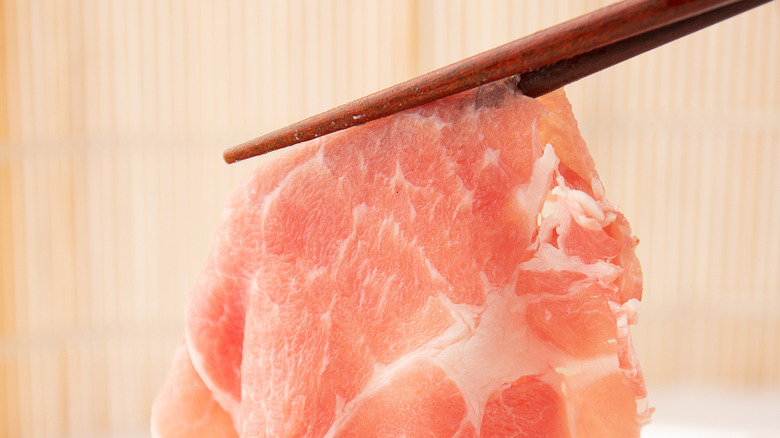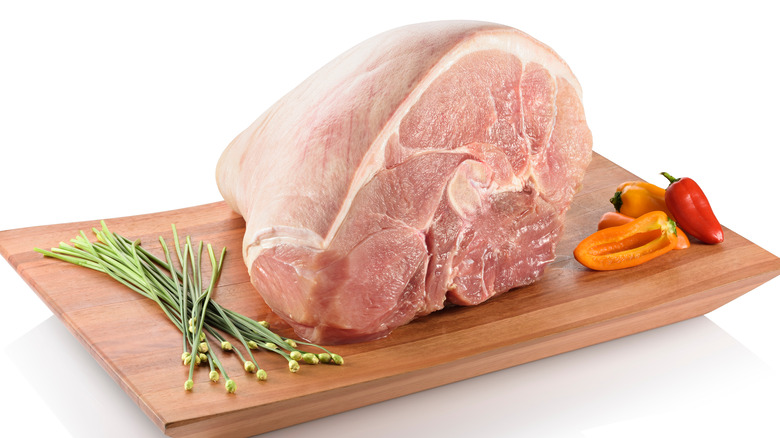How To Tell If Pork Has Gone Bad
One sure-fire way to know your pork has gone bad would be to wind up sick after eating it. But a better option is learning to identify the signs of hazardous pork before you require the aid of a professional healthcare provider. Fortunately, there are some easy-to-spot, tell-tale signs of spoilage that could save you a lot of discomfort (and medical bills).
According to the National Center for Biotechnology Information, the consumption of pork leads to 525,000 foodborne infections, 2,900 hospitalizations, and 82 deaths each year. While this number may seem quite off-putting, don't swear off pork chops or bacon just yet. One must remember that when compared to the amount of pork consumed by Americans each year — 67 pounds per capita in 2019 — it remains a safe protein to eat.
But as with any food product, there are rules that home cooks should follow to ensure their family's safety.
Check the expiration date
Everyone has that one friend who treats expiration dates like mere "suggestions," transforming every meal into a game of culinary Russian Roulette. Contrary to what they may believe, no one has an actual cast-iron stomach and, eventually, hazardous eating habits might catch up with them. A wise home cook pays attention to best-before dates; here's how those expiration dates are actually determined.
The U.S. Department of Agriculture has provided Americans with science-based, easy-to-follow rules regarding "sell-by" dates and pork. First, any pork product with a sell-by date should be cooked or frozen within three to five days of purchase. Remember, refrigeration merely slows down the spoiling process — it doesn't completely prevent bacteria from growing. Second, if you have thawed frozen pork in your fridge, it should remain viable for three to five days as well.
A "sell-by" date, however, is not the same as an expiry date, so be sure to read the label carefully. When it comes to raw meat, it's always better to err on the side of caution, with many chefs recommending never eating pork that's past its expiration date.
Check the smell
If you really want to know whether your packaged pork has gone bad, smell it. (And if you've been accused of having a lousy sense of smell, go find someone with a finely-honed sniffer and have them take a whiff of the raw meat.) A healthy piece of pork should be relatively odorless.
Medmunch explains that when pork is going bad, it emits a "sour odor" or a smell similar to ammonia that gets worse over time. And, you may come to find out, cooking it will intensify the stench, spreading it around your kitchen and firmly planting it within the depths of your nostrils. Peachy.
It's worth noting that certain packaging may make your meat smell odd. How, then, do you determine if the wrapping is the source of the strange scent? Simply Healthy Family recommends rinsing the pork and drying it off before checking out its aroma. If the weird smell is still there after washing, the packaging wasn't the culprit. A bevy of gut-twisting bacteria is likely the cause, so toss those chops in the trash immediately.
Check for gray spots
In addition to smell, sight is another way to tell if that package of fresh pork sitting in your fridge could potentially make you sick. If your pork is starting to lose its pinkish hue and is developing spots of grey, it's time to file it under "G" for garbage. And if the fat looks yellowish, that's another good indicator that it's off. Pork shouldn't be slimy, either — per Livestrong, the biggest tip-off pork has gone bad is when there's a slime-like film. And if it stinks or smells sour, or feels mushy or dry, don't eat it.
And if you've left your frozen pork chops thawing on the countertop all day or have tried using a quick-thaw method of sitting them in hot water, you'll need to toss them in the trash. Yes, the U.S. Department of Agriculture says that neither of these thawing options are considered safe. If your frozen pork has a few freezer burns, you can cut them out by taking an extra inch off the surrounding area. If it's more than just a few burn spots, it's best to toss it.
No one wants to be responsible for cooking a dish that makes family and friends sick. By following these tips, you'll be better able to keep your loved ones safe. Above all, remember one important rule: When in doubt, throw it out. But if your meat is still in good condition, try one of these delicious pork recipes for dinner.



